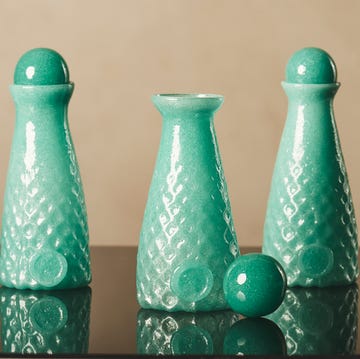One day in 1961, Maija Isola noticed the way sunlight danced through her curtain, casting rhythmic shadows across the fabric. With scissors and coloured paper, she created a set of matching cut-outs. The result was ‘Lokki’, a textile print that combines graphic geometry with a hand-rendered feel. It is one of more than 500 patterns Isola created for Marimekko, the Finnish design brand that was founded in 1951. Each one channels the sense of energy that reflected the creative spirit of this fiercely independent designer.
Marimekko founder Armi Ratia came across Isola’s work in 1949, when the designer participated in a competition at Helsinki’s Central School of Applied Arts. At a time when post-war Europe was craving optimism, Ratia saw Isola’s use of colour and motif as the perfect antidote. Initially working for Printex Oy, the textile-printing company that became Marimekko, Isola’s early designs included ‘Amfora’, a print inspired by ancient pottery she encountered at the Oslo Museum of Craft and Design on her first overseas trip.
Another was ‘Hevonen’, which highlighted her affinity with the horses she grew up with on her family’s farm in Riihimäki. In 1964, she cemented her place in history with ‘Unikko’, the poppy print that became Marimekko’s signature. In classic Isola style, it was born in defiance. Ratia had banned floral prints, believing them to be a poor substitute for the real thing. Isola set out to prove otherwise. Her bold design was an instant hit. Neither soft nor sentimental, it was a statement that captured the mood of the flower-power age.
What's everyone reading?
Isola designed for Marimekko until 1987, later collaborating with daughter Kristina Isola, but always following her own path. Her process was personal and intuitive, inspired by retreats to the Finnish countryside and by her travels across Europe and North Africa.
Some patterns are rooted in nature, taking cues from the shape of rocks or the movement of water; others feature diverse references ranging from Nordic folk craft to Arabic architecture. She often produced these designs sitting cross-legged on the floor, using gouache paint and crayons as well as her paper cut-outs.
A recent collaboration between Marimekko and Finnish homeware brand Artek saw three of Isola’s patterns – ‘Lokki’, ‘Kivet’ and ‘Seireeni’ – applied to classic Alvar Aalto-designed birchwood furniture. Twenty four years after Isola’s death, her legacy proves the continuing power of pattern to surprise, inspire and delight.
















